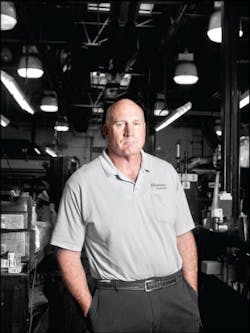In theory, the numbers always seemed to add up. More customers coming through the shop, more chances to inspect vehicles, more opportunities to find additional repairs, more chances to turn first-time customers into loyal, steady work for the shop. How could it not help?
The truth is, Tim Stapleton crunched the numbers on adding an express lube aspect to his business for years. And they always seemed to work—again, in theory.
“There are a lot of factors that go into making any change successful, though” he says.
But Stapleton just wasn’t sure if all those factors aligned for GT Automotive to make that plunge. The South Jordan, Utah, shop was already very successful, generating just north of $800,000 in annual gross revenue. Still, that success had plateaued a bit, and Stapleton was entering the stage of his career where he was beginning to focus on an exit strategy.
He needed the shop to take the next step, a large step that would solidify its future growth potential. And Stapleton wondered if adding an additional service to his shop’s offerings was the right direction.
“I had thought about express lube quite a bit, and it just seemed like something that would really complement every other aspect of my business,” he says. “But, like anything, it has to be done right in order to work.”
The Backstory
Growth and change have been just about the only two constants for the business since Stapleton opened GT Automotive Inc. in 1980 out of a small, two-bay garage in the Murray, Utah, area.
As it grew, the shop bounced around locations: First, it moved into a strip mall, eventually taking over the whole complex; later, it moved into a 10,000-square-foot facility across town.
That’s when Stapleton first attempted to differentiate his business. In the larger location, he and his business partner at the time decided to open a collision repair segment.
He hired a handful of experienced technicians and a seasoned manager, and the business thrived for a few years before that manager took a job with an insurance company.
“The body shop side sort of came apart after he left,” Stapleton says. “He was a really, really good manager, and we relied on him for a lot of it.”
Stapleton eventually had to close the body shop.
Although disappointing, the experience provided a valuable (and positive) lesson: Adding a segment to the business could work, Stapleton says, if there’s a commitment to make sure it’s done correctly, and if the right people are put in place to operate it.
The Problem
In 2000, Stapleton used the extra square footage from the body shop to expand his mechanical business. He also bought out his partner and began doing everything he could to grow his shop’s market share in the area. He focused more heavily on marketing, he revamped processes and procedures to increase efficiency, and he joined a 20 Group.
And business grew. Each year, his client list became longer, and his shop’s reputation became stronger.
“We had a location, though, that even though it was nice, it was sort of off the beaten path. It wasn’t on a main road,” Stapleton says. “We didn’t get a whole lot of people just driving by and coming in. It was all through referrals or our marketing.”
By 2003, Stapleton was starting to look into quick service jobs as a way to increase that walk-in traffic and bring in a larger customer base.
With his facility and location, though, he wasn’t sure how to make the concept work—or if it was even the best option.
The Options
Although the shop was in a good financial state, Stapleton didn’t want to keep the status quo. He wanted higher revenue and improved profitability. That meant he needed to take the company in a new direction, and his mind kept returning to express lube as the most viable option.
If he were to add express lube to his existing location, though, it would mean taking up bays being used by heavier mechanical jobs—ones with greater profit margins and higher-dollar invoices.
EXPERT ADVICE
Rick White, One Eighty Business Solutions LLC
Be Profitable FirstThe big thing when you’re looking at retiring, selling the business or moving on, like Stapleton was, is that the valuation is typically going to be the book value—or the value of your assets—plus five years of profit. It’s essential to be as profitable as you can be before even considering selling, and it needs to be part of at least a five-year plan to do so. Really, with any major addition or transition in your business, you want to focus on profit first.Inside or Out In certain situations, setting up a new service as a separate segment of the business can be best, but that’s not the only way to do it. It might’ve been Stapleton’s best option with the lube service, but there are a lot of shops that have successfully done it within the main repair shop. When you do it that way, you are able to retain the same level of work—the inspections, evaluations, etc.—in each vehicle. With regular service each vehicle is an opportunity because you’re focused on quality and finding additional work. With quick lube, it’s more about activity—getting things in and done as fast as you can. You have to do what’s right for your shop.A Marketing ToolI like to look at the quick lube component as part of your overall marketing. The goal should be to get a large percentage of the business coming over from the quick lube to the mechanical shop. That’s when it works: when it feeds the repair side. It’s similar to glass work. Glass repair can work because it exposes you to more people than you would already have. You should always be trying to find new ways to feed your current business—and that’s marketing.Increasing the shop’s physical size wasn’t the answer, either. At 10,000 square feet, the facility was already as big (or larger) than he would ever want. Plus, Stapleton wasn’t sure his location would generate enough drive-by customers to make an express lube segment viable.
If he was going to make this concept work for his business, he needed a new facility in a new location.
The Decision
To be clear: The entire goal of the express lube segment was to funnel additional clients and new work to the mechanical shop. That’s why opening a second, quick-service-only location was never really considered.
Still, Stapleton had done his homework on express lube (he toured dozens of facilities and spoke with many industry veterans, including those in his 20 Group), and knew that he needed to operate it as a separate segment of his business with a different staff, management system and financial reporting.
That narrowed down his criteria for a new facility: He needed to be on a main road (to generate walk-in customers), he needed ample space to keep the mechanical side fully operational, and he wanted the building to be an upgrade to his shop’s current aesthetics with a better waiting room and better overall amenities for customers and his staff.
After surveying the real estate market in his area, Stapleton realized that to do this, he’d have to build a shop from scratch.
He purchased land in 2004—a property that met all his customer demographic needs—and used $1.5 million in financing to break ground on the new, improved facility he had envisioned.
GT Automotive moved into its new South Jordan location in April of 2005.
The Aftermath
Stapleton was careful with how he planned out the new facility, he says. He had a specific design he wanted for it, a blueprint he put together from his countless shop tours and his 25 years of experience.
The new building, with its sharp, all-red-brick exterior, has three quick-service bays (with below-ground, under-car workspace) and eight full-mechanical bays, split by a shared lobby. Each business segment has a different counter in the lobby.
Although it measures out to only 8,000 square feet, Stapleton says a more efficient layout makes it feel much larger than his previous location.
Learning from his body shop days, Stapleton made sure to hire a veteran express lube manager to take charge of the operation from the get-go. He also hired four full-time lube techs. The mechanical side stayed virtually unchanged, apart from the improved efficiency generated from the better floor layout.
Stapleton says the quick-service segment wasn’t instantly profitable. But, between the shop’s location and a marketing push prior to opening, it was instantly busy. It started to push work to the mechanical side from Day 1.
Stapleton has his technicians perform a complete inspection on every vehicle that comes through the express lube bays. So, even though the segments operate separately, work is referred back and forth.
Also, he stresses his quick-service staff to focus harder on customer relationships than the average express lube shop might. He wants “meaningful” communication between staff and customers, and he wants the customer to feel comfortable waiting in the shop. It’s why he designed a large waiting room with comfy seating, free WiFi, computer access and a 300-gallon saltwater aquarium.
The average repair order is now roughly $450 in the main shop, and $70 in the quick-service bays. The work mix in 2013 has been about 2.5 to 1, Stapleton says, right in line with his goals. The business sees nearly 900 total vehicles per month, all but about 225 are express lube. The express bays do nearly $50,000 per month in sales; the mechanical bays earn just above $100,000.
The shop is on pace to make well above $1.5 million in total revenue in 2013.
The Takeaway
If you’re going to make a change in your business, Stapleton says, you have to look at the big picture. You have to be looking down the road; you have to be looking at all angles of your business and how it can really improve.
“Sometimes to make that change you have to really redo your business from the ground up,” he says. “That’s what we did. We rebuilt it from the ground up, and I’m not sure it could’ve worked any other way.
“If you’re looking to make improvements, you’re going to have to make changes. You need to really plan that out and not be afraid to really change things up.”
About the Author

Bryce Evans
Bryce Evans is the vice president of content at 10 Missions Media, overseeing an award-winning team that produces FenderBender, Ratchet+Wrench and NOLN.
